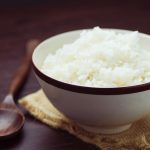 For several years now the FDA has known that levels of arsenic in rice are much higher than is healthy. They just don’t know what to do about it.
For several years now the FDA has known that levels of arsenic in rice are much higher than is healthy. They just don’t know what to do about it.
Arsenic is a Class 1 Carcinogen, meaning it is a cancer promoter. Its on the same level as cigarette smoking, asbestos, and formaldehyde. Arsenic also contributes to heart disease, diabetes, and immune system dysfunction. When the sleeping chicken pox virus wakes up and gives us shingles, one reason could be arsenic-related immune system weakness.
There is some arsenic naturally in our environment, and at small doses our bodies can process it. However in larger doses, thats not the case.
There are no FDA standards for acceptable levels of arsenic in foods, just in water and some juices. Ideally the level of arsenic in any of our foods or beverages would be zero, but we don’t have the technology to make that happen. The standard for arsenic in water is higher than it should be, but that’s not the only reason arsenic levels in rice are at an unhealthy level.
Why are the arsenic levels so high in rice?
For years arsenic-based pesticides were sprayed on fields, especially cotton fields. While those pesticides are now banned, the arsenic is still in the soil. So crops now grown in old cotton fields, which are mostly rice, are absorbing arsenic from the soil. Agriculture businesses created strains of rice that could grow in arsenic-rich soil. I with they had created strains of rice that were resistant to arsenic absorption.
Another contributor of arsenic is chicken manure. Chickens bred and raised in close quarters are given antibiotics to prevent the infections common in these living conditions. Some of the antibiotics they are given contain arsenic. When the manure from those chickens is then used as fertilizer, the soil gets contaminated. Arsenic, like any heavy metal, doesn’t break down in nature.
This is why I recommend organic chicken. The arsenic levels in conventional chicken are high too, but not as high as rice.
Is this something to really worry about?
The standard for something being safe in terms of cancer is if it causes less than one incidence of cancer for every million people. So, no more than one person in one million would get cancer from exposure. The arsenic levels in rice (and some drinking water), however, can cause an increase of one in 300. That means frequent consumption of arsenic at this level could cause a million cancer cases in the USA. That’s a lot of potential cancers.
This is an even bigger problem for people who need to stick to a gluten-free diet. So many gluten-free products use rice flour instead of wheat flour, and the arsenic levels can really add up. If you are gluten free, seek out gluten-free products made with other grains and flours such as buckwheat, quinoa, chickpea and lentil.
What should we do?
- Limit rice consumption to no more than 2-3 times a week. This includes rice milk, snacks like rice cakes, and regular rice.
- Buy rice grown in California. Fields in California were not treated with as many arsenic-based pesticides and so the soil is less contaminated. California rice has about half the arsenic as rice grown in the Southern states. The Lundberg brand, based in California, is working hard to reduce arsenic levels in their rice. to even lower levels.
- Expand to red and black rices, not just white and brown. They have lower levels of arsenic too.
- When possible, cook rice the way you would cook pasta – in a big pot of boiling water. Taste test to see when its done. About half of the arsenic will leach into the cooking water and go down the drain.
- Experiment with other whole grains like quinoa, barley, and farro. At some stores you can find millet and amaranth too – give them a try. All grains are best with a little olive oil, salt and pepper. Pearled barley (the most common kind in the market) makes a great substitute for rice in stuffing mixtures. Trader Joe’s has a 10-Minute Barley and 10-Minute Farro that make this easy.
- Use cauliflower “rice” when you just need a base for an entree. Cauliflower rice is simply cauliflower cut into small, rice-sized pieces. Cook it in a little olive oil in a skillet until its tender. You can find it in the frozen foods section of the market.
- Check the level of arsenic in your tap water by going to your water company’s website and accessing their Clean Water Report. If its higher than 3 ppb (parts-per-billion) you will want to use a water filter for drinking and cooking water. I checked Irvine Ranch Water District, there was no arsenic detected in the latest report.
Its frustrating when foods that should be healthy pose a health risk. The best we can do is act on this information to modify our diet and keep pressing for a safer food supply.
The good in this is now we have more incentive to try a variety of grains, and we will be all the healthier for it. Variety in foods brings us variety in nutrients. When it comes to nutrients the more the merrier. They all seem to work synergistically creating a whole that is greater than the sum of the parts.
Here is a great recipe for a sexy, modern barley bowl to get you started: http://www.101cookbooks.com/archives/california-barley-bowl-recipe.html
Let me know how it goes!
Leave a Reply